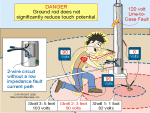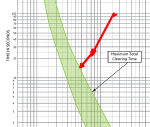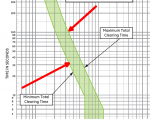mbrooke
Batteries Included
- Location
- United States
- Occupation
- Technician
I don't believe time is much of a factor for magnetic trip function, basically the time to mechanically operate once trip operation commences is about the only time factor involved. Otherwise the condition to start magnetic trip is based on current level, you either reached magnetic trip level or else it will be tripping after delay on thermal trip operation.on the tail end of 110.24A >>>
The calculation shall be documented and made available to those authorized to design, install, inspect, maintain, or operate the system.
one would think mag trip time would factor in here?
~S~
I don't think there is a simple calculation for this application.
It is a MWBC and yes balanced load would calculate out about like a three phase load would, but there is hardly any situaion of near balance in any individual segment of the layout.
Would be much simpler if you had three identical lights across all three phases at each light pole, then you could ignore the neutral and treat each pole as a 480 volt three phase load for the most part.
Instead you dropping current on one phase but also adding current to neutral at each pole, next pole you are doing the same but on another phase.
There may be shortcuts to get a reasonable in the field result, but if you want to know actual voltages at each point you about have to calculate each segment individually
How do you get no more than 3% from that?I don't think voltage drop would be over 3% if the run meets the requirement of 250.4 (A) 5.
I think you may find voltage drop of 3% or more easily at service equipment or first disconnect of separately derived systems during ground fault conditions, particularly on smaller capacity supplies that have pretty limited potential output to begin with.Quick background for the OP: mbrooke is raising the issue of an 'effective ground fault current path'. This is an unsettled topic.
He makes the not unreasonable claim that code requires that a ground fault trip a breaker at a certain speed, on the basis of NEC 250.4(a)5 in combination with other standards. In the installation being discussed, a short circuit at the far end would take many 10s of seconds to trip the breaker, and during this time all grounded metal at the far end of the circuit would be at elevated voltage and a shock hazard.
Others make the not unreasonable claim that this is an excessive interpretation. While a ground fault would cause a shock hazard, it would be transient in nature because if a circuit is designed with reasonable voltage drop the breaker will _eventually_ trip, and the vast increase in expense mitigating this risk would provide better safety benefit elsewhere. In general OCPD clearance time is not considered in these situations, so mbrooke has a bit of an uphill battle convincing the rest of us that it should be considered.
In the case of the installation being discussed, it would mean using roughly 6x the copper, solely to change the time it takes OCPD to clear a fault.
I'd suggest that the OP do a search for some of the other threads on this topic, rather than rehashing the discussion here.
-Jon
I think you may find voltage drop of 3% or more easily at service equipment or first disconnect of separately derived systems during ground fault conditions, particularly on smaller capacity supplies that have pretty limited potential output to begin with.

Quick background for the OP: mbrooke is raising the issue of an 'effective ground fault current path'. This is an unsettled topic.
He makes the not unreasonable claim that code requires that a ground fault trip a breaker at a certain speed, on the basis of NEC 250.4(a)5 in combination with other standards. In the installation being discussed, a short circuit at the far end would take many 10s of seconds to trip the breaker, and during this time all grounded metal at the far end of the circuit would be at elevated voltage and a shock hazard.
Others make the not unreasonable claim that this is an excessive interpretation. While a ground fault would cause a shock hazard, it would be transient in nature because if a circuit is designed with reasonable voltage drop the breaker will _eventually_ trip, and the vast increase in expense mitigating this risk would provide better safety benefit elsewhere. In general OCPD clearance time is not considered in these situations, so mbrooke has a bit of an uphill battle convincing the rest of us that it should be considered.
In the case of the installation being discussed, it would mean using roughly 6x the copper, solely to change the time it takes OCPD to clear a fault.
I'd suggest that the OP do a search for some of the other threads on this topic, rather than rehashing the discussion here.
-Jon
My comment was assuming ground fault to something solidly bonded. You will have this problem you posted here with most anything that is only grounded via electrode(s) or just plain contact with soil by the object in question.Right- I would argue in those cases you can confidently go up to 10 seconds without physiological danger since the voltage at the transformer terminals would dip substantially during a ground fault.
On the flip side 100-200 amps of fault current at a typical 2000 amp 480 volt service would not cause any significant dip in voltage at the transformer's terminals resulting in about 138 volts to remote earth (assuming EGC and phase are the same size). In reality however a voltage gradient (shell) may form around the metal base reducing the touch voltage the person is exposed, however it may still be around 100 volts.
Examples of reduced from gradient but still dangerous touch voltage:
View attachment 2556049
Anything like a fence, guard rial, bus shelter, sport equipment, ect may all become energized if sitting within the gradient- it does not have to contact the light post.
My comment was assuming ground fault to something solidly bonded. You will have this problem you posted here with most anything that is only grounded via electrode(s) or just plain contact with soil by the object in question.
Quick background for the OP: mbrooke is raising the issue of an 'effective ground fault current path'. This is an unsettled topic.
He makes the not unreasonable claim that code requires that a ground fault trip a breaker at a certain speed, on the basis of NEC 250.4(a)5 in combination with other standards. In the installation being discussed, a short circuit at the far end would take many 10s of seconds to trip the breaker, and during this time all grounded metal at the far end of the circuit would be at elevated voltage and a shock hazard.
Others make the not unreasonable claim that this is an excessive interpretation. While a ground fault would cause a shock hazard, it would be transient in nature because if a circuit is designed with reasonable voltage drop the breaker will _eventually_ trip, and the vast increase in expense mitigating this risk would provide better safety benefit elsewhere. In general OCPD clearance time is not considered in these situations, so mbrooke has a bit of an uphill battle convincing the rest of us that it should be considered.
In the case of the installation being discussed, it would mean using roughly 6x the copper, solely to change the time it takes OCPD to clear a fault.
I'd suggest that the OP do a search for some of the other threads on this topic, rather than rehashing the discussion here.
-Jon
This sounds like an ongoing debate from another thread. Surely for the purposes of this thread a simple reference to the other thread would suffice, rather than rehashing everything here?
Cheers, Wayne
We are getting off topic from the maximum of 3% voltage drop design that started this. I think an effective fault clearing path can have more then 3% voltage drop. Yes the less VD the more effective it can be, but I was merely stating even just VD in the source can be pretty significant in some cases.Even when solidly bonded, the EGC is nothing more than a potential divider. An EGC does not remove voltage (it never will), merely 277 volts is reduced to 138 volts relative to remote earth. If the object has rebar or metal going into the soil, a voltage gradient will forum around the footing- this typically provides some equal potential by small amount whereby 138 volts is reduced to 105 volts hand to foot.
Using ohms law and a 1000 ohm hand to foot resistance we obtain 105 milli-amps of current. According to IEC TS 60479-1 100 milliamps of current beyond 500 milliseconds has the ability to cause irreversible effects such as sustained ventricular fibrillation. At 1.5 seconds the probability of sustained ventricular fibrillation (death if no CPR and/or defibrillation is administered with seconds to minutes) exceeds 50%.
IEC makes extensive gestures toward physiological danger, while the IEEE makes extensive references toward fire, property damage, and fusing of the EGC. (see post below)
We are getting off topic from the maximum of 3% voltage drop design that started this. I think an effective fault clearing path can have more then 3% voltage drop. Yes the less VD the more effective it can be, but I was merely stating even just VD in the source can be pretty significant in some cases.
The IEEE Green Book, EPRI, and Eaton software makes the case that a breaker tripping in 10s of seconds may fuse the EGC since EGCs are typically smaller than the phase conductors (less than 1/10th the mm2 area) on the basis that it will carry fault current for very short periods of time.
Table 250.122 Inadequate?
Is 250.122 Inadequate in high fault current applications or where devices have been selectively coordinated? Some eye opening statments from the IEEE- 1) 2) 3)forums.mikeholt.com
selective coordination would seem to fit , in the sense that a little Z ,and it's all gone china ~RJ~
selective coordination would seem to fit , in the sense that a little Z ,and it's all gone china ~RJ~



